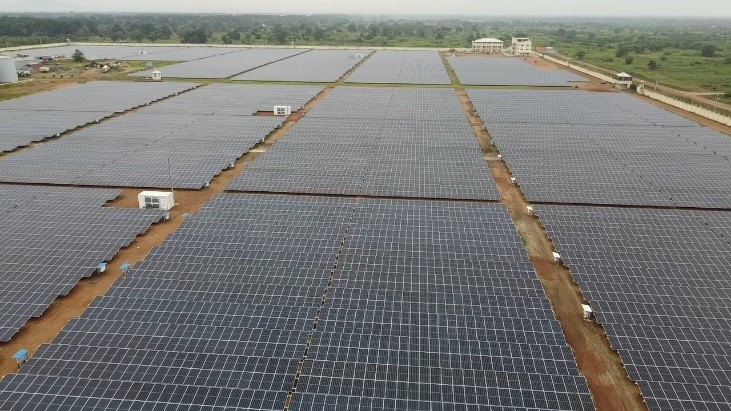Read the full original article here from Aptech Africa
Aptech Africa is pleased to report that it has brought to completion the installation of 26MWp of solar panels in Juba, South Sudan in a project self-financed by Ezra Construction Company. Aptech Africa has been permanently located in South Sudan since 2011, and is the EPC company of choice for solar installations within the country. Its team has carried out the EPC works, including the assessment, design, and solar panel installation for this project.
This solar power plant is a grid-connected system integrated with 30MW of diesel generators and has been completed in two phases, each phase with 13MWp. All the panels have been ground-mounted appropriately oriented at the right tilt and an azimuth to maximize sunlight capture. Ulica Solar Panels, specifically 540Wp modules in Phase I and 545Wp models in Phase II were used. The solar system employs a total of 108 Huawei inverters, each with a capacity of 200KTL. The solar installation is divided into 4STS (Smart Transformer Stations), each with a capacity of 6.5 MVA. Two of the STSs are connected with 28 inverters each, and the remaining two are connected with 26 inverters each.
The entire power plant will be remotely monitored through Huawei Fusion Solar, which is installed on site to communicate with all the inverters, STSs, and weather monitoring stations. It provides monitoring of PV generated power, generator supplied power, as well as fault detection capability, which assists in early problem solving and prevents future damage to the installed equipment. All of this can be accessed through eu5.fusionsolar.huawei.com, and locally through Huawei inverters individually, using USB cables that are compatible with both phones and laptops.
This power plant is significant because the entire city of Juba, South Sudan, relies on the power generated by the Ezra Power Plant. Prior to the installation of the solar system, there were severe load shading issues caused by maintenance problems with the existing diesel generation system. The diesel generation was unable to meet the demand, and the cost of diesel power generation was higher compared to solar power generation.
Due to the expensive nature of outsourcing diesel for power generation, EZRA came up with a solution to invest in renewable energy in order to reduce the cost of diesel generation. The solar plant now operates in conjunction with an existing 30 MW diesel plant, working together to ensure a reliable and cheaper power supply. During the daytime, approximately 30% of the power generation is sourced from the diesel generators to meet the load demand, while the remaining 70% is provided by the solar system. On average, the solar system has been generating between 90MWh to 120MWh of power per day.
As a result, the 26MWp solar power plant has successfully reduced the energy demand by approximately 40-70% per day, alleviating the load shading issues and providing a more cost-effective alternative to diesel power generation.
Aptech Africa went above and beyond to ensure that the client achieved their goal of having a more reliable and dependable power supply source for their loads by successfully installing and completing the 26MWp Solar Grid Connected system within the limited timeframe.
This power plant is now benefiting the entire city by reducing power interruptions and lowering the cost of energy per unit for consumers. This system will provide much needed electricity to over 525,000 people who live in Juba, South Sudan. Improved access to electricity will have a positive socio-economic impact on the entire city, improving services for hospitals, schools, and businesses.
Ezra Construction has in addition self-financed this project as part of its initiative to increase the contribution of renewable energy to Juba’s grid. This project will address the UN Sustainable Development goals 7 (Affordable Access to Clean Energy) and Sustainable Development Goal 13 (Climate action). This system has the potential to prevent 9,600 Kg of CO2 emissions per day, or almost 3800 tons of carbon emissions per year.



